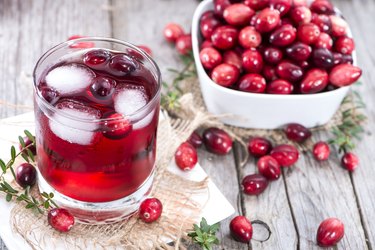
Gout, an inflammatory arthritis characterized by sudden severe pain and tenderness in the joints, is best managed by avoiding foods that trigger attacks. Cranberry juice for gout is not currently supported scientifically; doctors recommend drinking water or low-fat milk instead of fruit juices.
Tip
There is no evidence that shows drinking cranberry juice could trigger a gout attack, although there also are no current studies supporting the use of cranberry juice to treat gout flares.
Video of the Day
Gout Management
The Arthritis Foundation describes gout as an inflammatory arthritis that develops in some people who have high levels of uric acid in the blood. The acid can form needle-like crystals in a joint and suddenly cause severe episodes of pain, tenderness, redness, warmth and swelling. Symptoms of gout include intense joint pain, lingering discomfort, inflammation, redness and limited range of motion.
Video of the Day
According to the Mayo Clinic, the body produces uric acid when it breaks down purines, substances that are found naturally in your body or in food such as steak, organ meats, seafood, alcoholic beverages and drinks sweetened with fruit sugar.
Read more: Signs of High Uric Acid
The Clinic's first recommendation on a list of ways to manage gout is to drink plenty of fluids but to limit consuming sweetened beverages, especially those sweetened with high-fructose corn syrup. This would rule out drinking pineapple juice for gout or pomegranate juice for gout as these contain naturally occurring fruit sugars or added sweeteners, according to the USDA.
The Centers for Disease Control and Prevention describes common treatments for gout. These include managing the pain of a flare with nonsteroidal anti-inflammatory drugs (NSAIDs) like ibuprofen, steroids and the anti-inflammatory drug colchicine. To prevent future flares, you may make daily changes such as losing weight, eating less purine-rich food or changing or stopping medications like diuretics associated with hyperuricemia.
The CDC advises eating a healthy diet, meaning one that eliminates foods that could trigger a gout flare — such as red meat, organ meat and seafood — as well as limiting alcohol intake. The CDC also advises maintaining an active lifestyle but at the same time choosing activities that do not put too much stress on your joints.
Cranberry Juice For Gout
Cranberry, a native evergreen shrub, grows throughout North America and produces tart red berries. Cranberry juice is a popular drink that is widely available in stores, usually sweetened with added sugar or another fruit juice such as apple or grape. It is also available unsweetened, often labeled as pure cranberry juice.
Pure cranberry juice is distinguished from other commercially produced juices by the lack of any added sugar. The USDA shows that unsweetened cranberry juice contains the minerals calcium, magnesium, potassium, selenium, iron and zinc and is a good source of 15 essential vitamins including vitamins C, B6, B12, E, K and A as well as thiamine, niacin and riboflavin.
A one-cup serving of unsweetened cranberry juice contains 116 calories, almost a gram of protein and 30 grams of carbohydrates, according to the USDA. Although it is unsweetened, pure cranberry juice does contain 30 grams of naturally-occurring sugar. Because it's recommended that those who have gout avoid drinks sweetened with fruit sugar, cranberry juice for gout may not be a good choice.
The Arthritis Foundation cites research that shows drinking more water could mean fewer gout flares. Consuming dairy products, too, may help protect against gout attacks; one study showed that those who consumed a serving or more of low-fat milk or yogurt a day had less uric acid in their blood than those who abstained from dairy.
There are no current studies supporting the use of cranberry juice for gout treatment. There is also no evidence that drinking cranberry juice could cause a gout attack.
Read more: Foods That Will Eliminate Gout Flare Ups